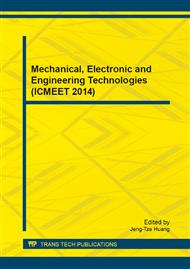p.356
p.360
p.367
p.371
p.375
p.379
p.383
p.387
p.394
Optical Flow-Based Monocular Vision/INS Integrated Navigation for Mobile Robot Indoors
Abstract:
This paper proposed a new algorithm for optical flow-based monocular vision (MV)/ inertial navigation system (INS) integrated navigation. In this mode, a downward-looking camera is used to get the image sequences, which is used to estimate the velocity of the mobile robot by using optical flow algorithm. INS is employed for the yaw variation. In order to evaluate the performance of the proposed method, a real indoor test has done. The result shows that the proposed method has good performance for velocity estimation. It can be applied to the autonomous navigation of mobile robots when the Global Positioning System (GPS) and code wheel is unavailable.
Info:
Periodical:
Pages:
375-378
Citation:
Online since:
April 2014
Authors:
Price:
Сopyright:
© 2014 Trans Tech Publications Ltd. All Rights Reserved
Share:
Citation:


